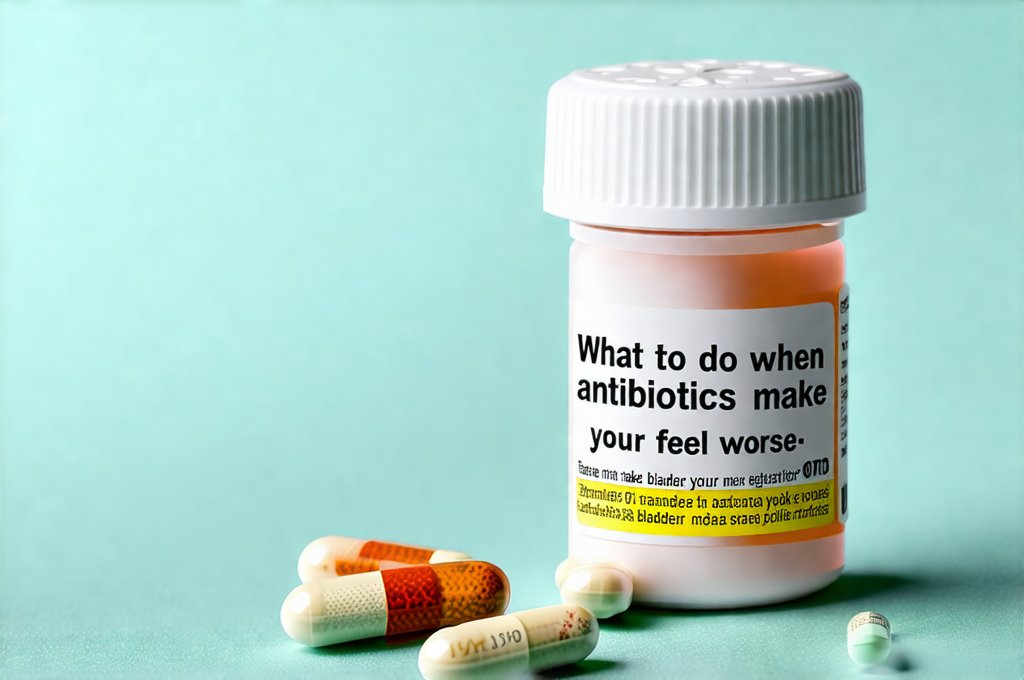Antibiotics are often life-saving medications, battling bacterial infections and restoring health. However, these powerful drugs aren’t without their side effects, and sometimes those side effects can be surprisingly disruptive – even affecting seemingly unrelated parts of the body. One area that’s frequently impacted is the urinary system, specifically leading to what feels like a worsening or new bladder issue during or after antibiotic treatment. This isn’t necessarily an indication of a new infection; it’s often a complex interplay between antibiotics disrupting natural bacterial balance and their potential impact on bladder function and sensitivity. Understanding why this happens, recognizing the symptoms, and knowing how to manage these issues is crucial for navigating antibiotic therapy with greater comfort and confidence.
This experience can be particularly alarming because many bladder-related symptoms – frequent urination, urgency, pain or burning sensation – mimic a urinary tract infection (UTI). This often leads patients to believe their initial infection hasn’t been fully eradicated or that they’ve developed a secondary UTI, prompting requests for more antibiotics. However, prescribing additional antibiotics in this scenario can sometimes exacerbate the problem and contribute to antibiotic resistance. It’s vital to understand the difference between an actual UTI and antibiotic-induced bladder irritation, and to explore alternative management strategies beyond simply adding more medication. This article will delve into these complexities, offering information about what causes this phenomenon, how to identify it, and steps you can take to alleviate discomfort while continuing your prescribed treatment.
Understanding Antibiotic-Related Bladder Symptoms
The connection between antibiotics and bladder issues isn’t straightforward. It’s rarely a direct toxic effect of the antibiotic on the bladder itself (though some rare exceptions exist). Instead, several mechanisms are usually at play simultaneously. The most common is disruption of the gut microbiome – that complex ecosystem of bacteria living in our intestines. Antibiotics aren’t selective; while they target harmful bacteria causing an infection, they also eliminate beneficial bacteria within the gut. This imbalance can ripple outwards, impacting the immune system and even influencing inflammation throughout the body, including the urinary tract. A healthy gut microbiome contributes to a robust immune response that helps keep opportunistic pathogens at bay, so when it’s compromised, the bladder may become more vulnerable to irritation.
Furthermore, antibiotics can alter the vaginal flora in women, reducing the number of protective Lactobacilli bacteria which normally prevent harmful bacteria from colonizing the urinary tract. This disruption increases the risk of developing a secondary bacterial imbalance that mimics a UTI. Another factor is heightened sensitivity. Antibiotics can sometimes increase nerve sensitivity in the bladder and pelvic region, leading to what’s known as “pelvic floor dysfunction” or simply an increased perception of urgency and discomfort even without inflammation present. Finally, some antibiotics are excreted through the kidneys and into the bladder, potentially causing direct irritation in sensitive individuals. Identifying which mechanism is at play can be difficult, but recognizing the overall pattern of symptoms helps differentiate this situation from a true UTI.
Recognizing the Signs: Differentiating Antibiotic-Induced Irritation from a UTI
Distinguishing between antibiotic-induced bladder irritation and an actual UTI requires careful observation and communication with your healthcare provider. While both conditions share overlapping symptoms, subtle differences can provide clues. Typical UTI symptoms include a strong, persistent burning sensation during urination, cloudy or bloody urine, lower abdominal pain, and often, a feeling of incomplete emptying of the bladder. The onset is usually relatively rapid and accompanied by systemic symptoms like fever, chills, and back pain in more severe cases. Antibiotic-induced irritation, on the other hand, tends to be less intense.
The burning sensation may be milder or described as stinging rather than searing. Urgency and frequency are common, but often without the same degree of debilitating pain. The urine is usually clear, and systemic symptoms like fever are typically absent. Importantly, symptoms often begin during or shortly after starting antibiotics, or even worsen as you finish the course, which is a strong indicator that it’s related to the medication itself rather than a new infection. A healthcare provider can perform a urinalysis to confirm whether bacteria are present in the urine and rule out a UTI definitively. It’s crucial not to self-diagnose or request additional antibiotics without proper medical evaluation. If you can’t pee but feel urgency, seeking professional guidance is important.
Managing Discomfort: Strategies for Relief During Antibiotic Treatment
If you suspect your bladder symptoms are related to antibiotic use, there are several steps you can take to manage discomfort while continuing your prescribed treatment (always discuss these with your doctor first). Hydration is paramount; drinking plenty of water helps dilute urine and minimizes irritation. Avoid bladder irritants like caffeine, alcohol, spicy foods, acidic fruits (citrus, tomatoes), and artificial sweeteners, as these can exacerbate symptoms. Consider incorporating probiotics into your diet or supplementing with a probiotic containing strains known to support gut health – this can help restore the balance of bacteria disrupted by antibiotics.
Pelvic floor exercises, such as Kegels, can strengthen the pelvic floor muscles and improve bladder control, but it’s important to perform them correctly; consider consulting a physical therapist specializing in pelvic health for guidance. Warm baths or applying a heating pad to your lower abdomen can also provide soothing relief. Finally, open communication with your doctor is essential. Discussing your symptoms honestly allows them to assess the situation accurately and adjust your treatment plan if necessary – perhaps by switching antibiotics (if appropriate) or recommending alternative therapies. Remember that the goal isn’t necessarily to eliminate all discomfort immediately, but rather to manage it effectively while allowing the antibiotic course to complete its intended purpose. If [UTIs affect your daily routine], consult with a medical professional.
Long-Term Considerations: Preventing Future Issues
Even after completing a course of antibiotics, some individuals may experience lingering bladder sensitivity or increased frequency. This highlights the importance of proactive strategies for maintaining overall urinary health and minimizing future disruptions. Focus on building a strong gut microbiome through a diet rich in fiber, fermented foods (yogurt, kefir, sauerkraut), and prebiotic-rich vegetables. Limit unnecessary antibiotic use whenever possible – this means only taking them when prescribed by a healthcare professional for bacterial infections and avoiding pressure to take antibiotics for viral illnesses like colds or flu.
Consider consulting with a pelvic floor physical therapist for ongoing support if you experience chronic bladder issues. They can provide personalized exercises and techniques to strengthen the pelvic floor muscles, improve bladder control, and reduce pain. Finally, prioritize stress management techniques such as yoga, meditation, or deep breathing exercises, as stress can exacerbate bladder symptoms. By adopting these preventative measures, you can minimize your risk of experiencing antibiotic-related bladder issues in the future and maintain a healthy urinary system for years to come. If [bladder pain appears suddenly], seek medical attention immediately.





















